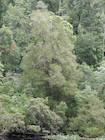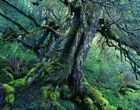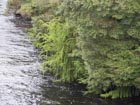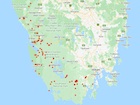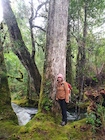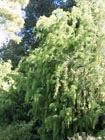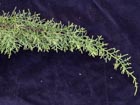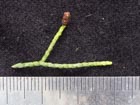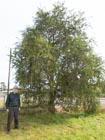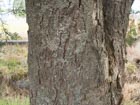Conservation Status

Lagarostrobos franklinii
(Hook f.) Quinn 1982
Common names
Huon pine (Silba 1986), Macquarie pine.
Taxonomic notes
Syn: Dacrydium franklinii Hooker (Quinn 1982). The sole species in Lagarostrobos C.J. Quinn 1982. A former second species, L. colensoi, has been segregated to the monotypic genus Manoao (Molloy 1995).
Lagarostrobos was formerly included in Dacrydium, but de Laubenfels (1969) segregated the genus Falcatifolium and Quinn (1982) further segregated the genera Halocarpus, Lagarostrobos, and Lepidothamnus, leaving Dacrydium as currently construed. These segregations were made on the basis of differences in
female cone morphology, a criterion that has been used as the taxonomic basis for differentiating all genera in the Podocarpaceae. "The name Lagarostrobos refers to the lax open nature of the female cone" (Quinn 1982).
Description
Trees to 25 m tall and 150 cm DBH, with a conical or pyramidal crown that spreads and becomes irregular with age. Bark gray, rugose, horizontally striated, with age developing longitudinal fissures; often obscured by epiphytes. Twigs pliable, 1-1.2 mm thick, covered in scale leaves, forming pendulous branches in shade or stiffer, more erect branches in sun. Juvenile leaves (found on seedlings) spirally arranged, decurrent with free apex, 1-2 mm long, keeled, acute. Adult leaves spirally arranged, imbricate, appressed, rhomboid, 1-1.5 × 1 mm, keeled, obtuse, with conspicuous, scattered stomata. Pollen cones solitary, terminal, sessile, 4-6 × 2-2.5 mm, with 10-15 microsporophylls. Seed cones terminal on short decurved twigs (i.e., cone terminal but pendent), 4-5 mm long, with 5-8 spirally arranged fertile bracts. Seeds ca. 2 mm diameter, notched at apex, light brown, epimatium fleshy, covering about half the seed at maturity (Quinn 1982, Farjon 2010, and pers. obs. 2015). See García Esteban et al. (2004) for a detailed characterization of the wood anatomy.
Asexual reproduction by layering is common and may cover large areas (Farjon 2010).
Distribution and Ecology
Australia: Tasmania, along river systems and in wet mountains (e.g. Mt. Read) near the southern and western coasts at altitudes of 150 to 600 m (Dallimore et al. 1967, Allen 1998). Within its range, mean annual temperature is 9.6°C, with an average minimum in the coldest month of 2.5°C, and a mean annual precipitation of 2106 mm (Biffin et al. 2011, Table S5). See also publications by Shapcott and Read, listed below. You can also create a highly detailed map, and access specimen data, using the "search" function at the Australia Virtual Herbarium.
"These trees reproduce vegetatively (by layering and root suckering) as well as by seed. The male and female cones are usually found on separate trees and the seeds are spread by water or by birds" (ANBG [no date]).
Hardy to Zone 8 (cold hardiness limit between -12.1°C and -6.7°C) (Bannister and Neuner 2001).
Formerly a dominant tree in some areas of the Tasmanian rainforest, extensive logging in the 19th and early 20th centuries nearly extirpated the species, reducing it to occasional remnant stands and isolated trees throughout much of its native range. In 2021, a substantial old-growth Huon pine stand was discovered along the Wilson River in the Tarkine area (Holbeck 2022.03.17, accessed 2022.03.20). This unique stand is, however, threatened by proposed mining activity.
Remarkable Specimens
[There are] "individuals that would take the arm spans of at least 3 people, possibly 4, to encircle" (Allen 1998). This is the closest I have come to finding a quantitative measure, but various anecdotal accounts support the idea that some extant trees are at least 200 cm dbh. Height data are even less common, but photographs support the existence of trees at least 30 m tall. Extensive stands of large old-growth Huon pine were formerly thought to have all been extirpated by logging, but in 2022 such a stand was reported from the Tarkine River area (Holbeck 2022); unfortunately it is in an area proposed for destruction by open-pit mining.
This species achieves greater ages than any other in the Podocarpaceae. A tree ring chronology collected by Ed Cook at Lake Johnson on Mt. Read in Tasmania (doi.org/10.25921/zdd7-6z16), containing a combination of subfossil and living wood, has produced crossdated records of 26 trees over 1000 years old; the earliest sample begins in 2145 BCE. The oldest specimen records 1773 years for a sample that ended in 1630, and the oldest living tree had 1082 years of record when sampled in 1988. Living trees sampled by increment borer are said to have yielded ring counted ages of up to 2500 years (Balmer 1999). The trees in the oldest stand, on Mt. Read near Roseberry, comprise a single male clone. Sediments from Lake Johnston on Mt. Read contain Huon pine pollen 10,500 years old, so it is plausible that this clone is more than 10,000 years old (Corbett [no date]). Among conifers, this is the longest period of time for which we have any indication of the continued persistence of a unique genetic individual, although it is possible that comparable ages could be matched by other clonal species such as Sequoia sempervirens, Picea mariana, and Taxus baccata. Much older clone ages have been demonstrated in non-conifers; currently the record seems to be an age of 43,600 years attributed to a Lomatia tasmanica clone that, somewhat ironically, grows in the range of Huon pine (DEWHA 2010).
Ethnobotany
The fragrant, soft wood is used for boatbuilding, furniture, cabinetry, turning and carving. It is a highly regarded specialty wood due to its aesthetic qualities and the appeal of owning something made from what is now thought to be the longest-lived tree in Australasia. The wood supply is restricted, natural stands having been largely logged or protected, but much of the logging was in areas slated for inundation due to hydroelectric development and the wood was stockpiled. At the current usage rate of about 500 m3/yr, the supply of sawlogs is expected to last 50 years (Timber Research Unit 2007). An oil obtained from the wood is used as a paint preservative. "The oil has been used for dressing wounds, treating toothache and as an insecticide. The timber is resistant to attack by rot and marine organisms" (ANBG [no date]). The rot resistance and sweetish odor of the wood is due to the presence of the essential oil methyl euganol (Corbett [no date]), which has been synthesized and is approved for us as a pesticide in the USA.
In research uses, dendrochronological methods have allowed samples from Huon pine to be used in radiocarbon time scale calibration (Barbetti et al. 1995) and studies of long term temperature variation (Cook et al. 1991, 1992, 1996). Because the wood is extremely rot resistant, subfossil specimens have enabled the construction of a continuous tree ring record covering over 12,000 years at the Stanley River site (Pepper 1999). This is one of the world's longest continuous tree-ring records.
Observations
The species is featured on the Huon Pine Track on the banks of the Huon River at Tahune, an easy day trip from Hobart (some photos from this stand are shown here).
The Mt. Read forest discussed above, in the Lake Johnston Nature Reserve, sounds to be worth a visit, but is difficult to access. Besides huon pine, the area also hosts most of Tasmania's other endemic conifers, including Athrotaxis selaginoides, A. cupressoides, A. laxifolia, Diselma archeri, Microcachrys tetragona, and Phyllocladus aspleniifolius. Diselma, normally a shrub, grows as a tree at sizes up to 10 m tall and 60 cm dbh (Corbett [no date]).
Remarks
Huon pine was named for the river in D'Entrecasteaux Channel, in the bed of which logs of the timber were found. It was first recorded by Alan Cunningham in 1818 (Dallimore et al. 1967).
Lagarostrobos comes from the Greek, lagaros "thin" and strobos "cone". The epithet franklinii remembers Sir John Franklin, 1786-1847, arctic explorer and governor of Tasmania from 1836 to 1843 (ANBG [no date]).
Citations
Allen, Kathryn. Department of Geography and Environmental Studies, University of Tasmania. E-mail 1998.11.10.
[ANBG] Australian National Botanic Gardens. [no date]. Australian Conifers. http://www.anbg.gov.au/anbg/conifers/, accessed 2002.11.09, now defunct.
Timber Research Unit. 2007. http://www.tastimber.tas.gov.au/species/pdfs/Huon.pdf, accessed 2010.10.03.
Balmer, Jayne. Botanist, Parks and Wildlife Service, Tasmania. E-mail 1999.08.18.
Cook, E. R., T. Bird, M. Peterson, M. Barbetti, B. M. Buckley, R. J. Francey, D. Martins and P. Tans. 1991. A 1089-year temperature record for Tasmania inferred from tree rings of subalpine Huon Pine. Science 253: 1266-1268.
Cook, E. R., T. Bird, M. Peterson, M. Barbetti, B. M. Buckley, R.D. D'Arrigo and R.J. Francey. 1992. Climatic change over the last millenium in Tasmania reconstructed from tree-rings. The Holocene 2: 205-217.
Cook, E. R., R. J. Francey, B. M. Buckley and R. D. D'Arrigo. 1996. Recent increases in Tasmanian Huon Pine ring widths from a subalpine stand: natural climate variability, or greenhouse warming? Papers and Proceedings of the Royal Society of Tasmania 130(2):65-71.
Corbett, Keith. [no date]. The Mount Read Huon Pine. http://www.apstas.com/Mt__Read_Huon_pine.html, accessed 2010.03.29, now defunct.
[DEWHA] Department of the Environment, Water, Heritage and the Arts (2010). Lomatia tasmanica in Species Profile and Threats Database, Department of the Environment, Water, Heritage and the Arts, Canberra. www.environment.gov.au/sprat, accessed 2010.03.29.
Holbeck, Megan. 2022.03.17. Treasure in the trees: ancient stand of Huon pines ‘discovered’. Australian Geographic, accessed 2022.03.20.
Tasmania Parks and Wildlife Service. 1999. Native Conifers of Tasmania. http://www.parks.tas.gov.au/index.aspx?base=3240, accessed 2010.10.03, now defunct.
Pepper, David. University of Sydney. E-mail 1999.09.14.
Tasmanian Public Land Use Commission. 1996. Public Land Commission
Brochures Page, Section 3.5.8, Mt Read RAP 175. http://www.delm.tas.gov.au/pluc/partb_35.html, accessed 1999.10.31, now defunct.
See also
Anonymous. 1984. Conservation of the Huon pine. World Wildlife Fund Newsletter 18:4.
Boland et al. (1985), p. 58-59.
Gibson, N. 1986. Conservation and management of Huon pine in Tasmania. Wildlife Division Technical Report 86/3. Hobart: Tasmanian National Parks and Wildlife Service.
Gibson, N. 1988. A description of the Huon pine (Lagarostrobos franklinii) (Hook. f.) C.J. Quinn forests of the Prince of Wales and King Billy Ranges. Papers of the Proceedings of the Royal Society of Tasmania 122:127-133.
Gibson, N., J. Davies and M. J. Brown. 1991. The ecology of Lagarostrobos franklinii (Hook. f.) Quinn (Podocarpaceae) in Tasmania. 1. Distribution, floristics and environmental correlates. Australian Journal of Ecology 16(2):215-222.
Gibson, N. and M. J. Brown. 1991. The ecology of Lagarostrobos franklinii (Hook. f.) Quinn (Podocarpaceae) in Tasmania. 2. Population structure and spatial pattern. Australian Journal of Ecology 16(2):223-230.
Hickey, J. F. and K. C. Felton. 1988. Subalpine Huon pine near Frenchman's Cap. Tasmanian Naturalist 93:1-4.
Kerr, Garry and Harry McDermott. 2000. The Huon Pine Story. Portland, Victoria: Mainsail Books. ISBN=0-95779170-4.
Mostly a human history, with some natural history.
Kershaw, P. 1983. Huon Pine - Australia's longest living tree - tells an epic story of survival. Habitat Australia 11:32-34.
Millington, R. J. 1982. Woodman, spare that tree. Geo 4:124-131.
Millington, R. J., Jones, R., Brown, D. and Vernon, B. 1983. Huon Pine: Endangered? (Environmental Studies: University of Tasmania).
Pedley, J., Brown, M. J. and Jarman, S. J. 1980. A Survey of Huon Pine in the Pieman River State Reserve and Environs. Wildlife Division Technical Report 80/2. Hobart: Tasmanian National Parks and Wildlife Service.
Peterson, M. J. 1990. Distribution and Conservation of Huon Pine. Hobart: Forestry Commission of Tasmania.
Read, J. 1985. Photosynthetic and growth responses to different light regimes of the major canopy species of Tasmanian cool temperate rainforest. Australian Journal of Ecology 10: 327-334.
Read, J. 1989. Phenology and germination in some rainforest canopy species at Mt Field National Park, Tasmania. Papers and Proceedings of the Royal Society of Tasmania 123: 211-221.
Read, J. and R. S. Hill. 1988. Comparative responses to temperature of the major canopy species of Tasmanian cool temperate rainforest and their ecological significance. I. Foliar frost resistance. Australian Journal of Botany 36: 131-143.
Read, J. and J. R. Busby. 1990. Comparative responses to temperature of the major canopy species of Tasmanian cool temperate rainforest and their ecological significance. II. Net photosynthesis and climate analysis. Australian Journal of Botany 38: 185-205.
Read, J. 1995. The importance of comparative growth rates in determining the canopy composition of Tasmanian rainforest. Australian Journal of Botany 43: 243-271.
Shapcott, A. 1991. Studies in the Population Biology and Genetic Variation of Huon Pine (Lagarostrobos franklinii). Tasmanian NRCP Report No. 4. Hobart: National Rainforest Conservation Program.
Shapcott, A. 1991. Dispersal and establishment of Huon pine (Lagarostrobos franklinii). Papers and Proceedings of the Royal Society of Tasmania 125:17-28.
Shapcott, A. 1995. A Huon pine story. [report on a study of the population ecology and population genetics of the species] Danthonia 4(3):3-4.
Shapcott, A., M. Brown, J. B. Kirkpatrick and J. B. Reid. 1995. Stand structure, reproductive activity and sex expression in Huon Pine (Lagarostrobos franklinii (Hook f.) Quinn.) Journal of Biogeography 22.
Tasmania Forestry Commission. 1987. Management Policy for Huon Pine. Hobart: Forestry Commission.
